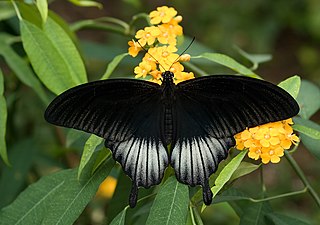
Papilio memnon, the great Mormon, is a large butterfly native to southern Asia that belongs to the swallowtail family. It is widely distributed and has thirteen subspecies. The female is polymorphic and with mimetic forms.

Belenois aurota, the pioneer or pioneer white or caper white, is a small to medium-sized butterfly of the family Pieridae, that is, the yellows and whites, which is found in South Asia and Africa. In Africa, it is also known as the brown-veined white, and is well known during summer and autumn when large numbers migrate north-east over the interior.

Papilio clytia, the common mime, is a swallowtail butterfly found in south and southeast Asia. The butterfly belongs to the subgenus Chilasa, the black-bodied swallowtails. It serves as an excellent example of a Batesian mimic among the Indian butterflies.

Pseudophilotes baton, the baton blue, is a butterfly of the family Lycaenidae. It is found in central and southern Europe and then east across the Palearctic to the Russian Far East.
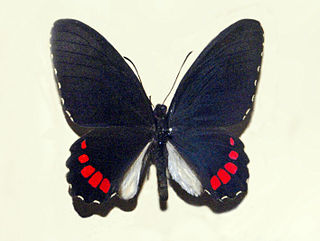
Parides erithalion, the variable cattleheart, is a North and South American butterfly in the family Papilionidae. The species was first described by Jean Baptiste Boisduval in 1836.
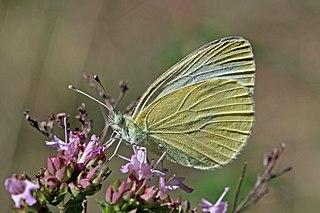
Pieris ergane, the mountain small white, is a butterfly of the family Pieridae. It is found in Southern Europe, Asia Minor, Syria, Iraq, Iran and Transcaucasia.

Papilio torquatus, the torquatus swallowtail, is a swallowtail butterfly in the subfamily Papilioninae. It is found from northern Argentina to Mexico.

Papilio androgeus, the Androgeus swallowtail, queen page, or queen swallowtail, is a Neotropical butterfly of the family Papilionidae. It is found from Mexico to Argentina with a small population in southern Florida.

Mimoides phaon, the red-sided swallowtail or variable swallowtail, is a species of butterfly in the family Papilionidae. It is native to the Americas.
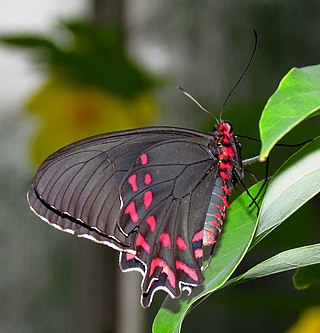
Parides photinus, the pink-spotted cattleheart, is a species of butterfly in the family Papilionidae. It was first described by Edward Doubleday in 1844.
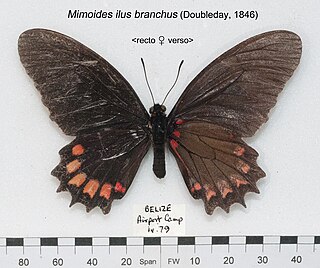
Mimoides ilus, the Ilus swallowtail or dual-spotted swallowtail, is a species of butterfly in the family Papilionidae. It is found from Mexico to Colombia and Venezuela. Little is known about this rare butterfly, but it is not considered threatened. The larvae of M. i. branchus feed on Annotata reticulata.

Parides sesostris, the emerald-patched cattleheart or southern cattleheart, is a species of butterfly in the family Papilionidae.
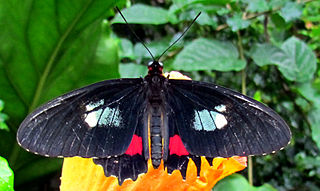
Parides iphidamas, the Iphidamas cattleheart or Transandean cattleheart, is a species of Neotropical butterfly in the family Papilionidae.
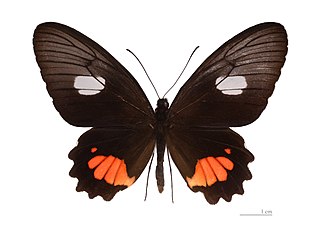
Parides anchises, the Anchises cattleheart, is a species of butterfly in the family Papilionidae native to the Americas. It is common and not threatened. The larvae feed on Aristolochia species including: A. brazilsis, A. bukuti, A. colombiana, A. cymbifera, A. fimbriata, A. inflata, A. macroura, A. odora, A. ringens, and A. triangularis.

Euryades duponchelii is a species of butterfly from the family Papilionidae first described by Hippolyte Lucas in 1839. It is found in Brazil, Argentina, Paraguay, Uruguay, and Bolivia.
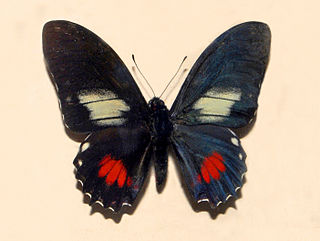
Mimoides euryleon, the false cattleheart swallowtail, is a species of butterfly in the family Papilionidae.

Mimoides lysithous is a species of butterfly in the family Papilionidae. It is found in the Neotropical realm.

Mimoides pausanias, the Pausanias swallowtail or bluish mimic-swallowtail, is a species of butterfly in the family Papilionidae.

Mimoides protodamas is a species of butterfly in the family Papilionidae. The common name is false polysticto, with reference to the similarity of this species with Battus polystictus.

Eurytides calliste is a species of butterfly in the family Papilionidae. It is found in the Neotropical realm.




















